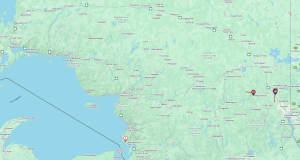
A STEEL RIVER RUNS THROUGH IT: In fact, two rivers of twin steel rails run through Canada’s economy and the Thompson River Canyon. Left – CN Toronto-Vancouver priority freight train Q101 moves more than 300 containers heading for export at the Deltaport on the Pacific Coast on July 4, 2022. Part of a fleet of CN transcontinental freight trains, Q101 removes 300 or more containers daily from the publicly-funded Trans-Canada Highway at no cost to taxpayers. So do CP’s transcontinental trains, which operate on their line to the right and above the CN main line here at Walhachin, B.C. (shown on the right). Photos by and through the courtesy of Ray Farand
To paraphrase Gordon Lightfoot, “There was a time in this fair land when the railroads were well run.” But no more – at least to hear their customers tell it.
Shippers are screaming at Canadian National (CN) and Canadian Pacific (CP) for not providing what they deem an adequate supply of empty cars and delivering the loaded cars reliably. Asset stripping, cost cutting, rate jacking and corporate arrogance are some of the nasty terms being flung in anger by the shippers.
The loudest voices belong to bulk shippers, whose commodities can only move rail because of their weight, bulkiness or high volume. Examples in Northern Ontario are minerals, forest products and chemicals. Also, rail-dependent for long hauls are containers handling a wide range of consumer goods sold in Northern Ontario stores, which includes everything from clothing to car parts to computers.
There are many factors in the decline of rail dependability, but listing them all here won’t solve anything. Let’s just say rail freight service isn’t what it used to be. But then shippers also have many of the same complaints about trucking and the other freight modes.
So why do these shippers still use rail? Because of its unique and inherent advantages over its main competitor, trucking. The efficiency of steel wheels rolling on steel rails is vital in moving many commodities over certain distances. One double-stacked, 300-container intermodal train replaces 300 trucks. One tonne of freight moves four times farther by train than by truck on the same amount of fuel.
While shippers demand immediate improvements by this steel-rail-and-wheel enabler of their businesses, the feds say they’re aware of the seriousness of the situation… and they’re studying it. A National Supply Chain Summit and a National Supply Chain Task Force to “identify” the problems have been Ottawa’s responses.
In all this finger-pointing and foot-dragging, Ottawa and the shippers have failed to address the problem’s root cause: decades of skewed transportation policy and spending. The result is a system that doesn’t make the best use of each mode, disadvantages the railways, and saddles taxpayers with hidden subsidies for every mode except long-haul rail freight.
The polite term is cost externalization. A blunter one is free lunch. The pandemic and closures of the main southern B.C. transportation corridor due to fires and floods only inflamed this pre-existing condition.
In 1975, a U.S. agency examining the collapse of a large portion of the American rail system determined a principal cause of its service and financial failures was “massive public support for the newer auto, truck, barge and airline technologies through the provision of public funds for ground facilities and rights-of-way. Only a portion of these costs are repaid by user charges.”
The same situation then existed in Canada and it still does. It continues to chew away at rail’s competitiveness and market share, effecting the quantity and quality of service. The cure is policies requiring users to pay a larger share of the cost of the facilities and services they use.
CN and CP are already user-pay carriers, covering their costs without subsidies and offering service at compensatory rates. Highways recover less than half of their costs in user fees and taxes.
Where government determines an unprofitable service is necessary in the public interest, it would be publicly funded under new federal and provincial transportation policies. All modes would be treated equally in the awarding of the funding, with operators chosen through cost-benefit and alternatives analyses. Only then would the current Canada Transportation Act (CTA) be more than lofty rhetoric.
The CTA calls a competitive, economic and efficient transportation system “essential to serve the needs of its users, advance the well-being of Canadians and enable competitiveness and economic growth in both urban and rural areas throughout Canada.”
That is most likely to be achieved, says the CTA, “… when competition and market forces, both within and among the various modes of transportation, are the prime agents in providing viable and effective transportation services.”
That objective won’t be realized until modal competition is fair. Failing to charge some modes for their publicly-funded facilities and services, while compelling others to cover all their costs, has warped Canada’s transportation system. That’s why it isn’t meeting shipper expectations.
Our economy, our cost of living, the competitiveness of Canadian products and the jobs they generate depend on attacking the core of the current supply chain’s problems, not just nibbling around its edges once again. This especially applies to any restrictions on deriving the maximum benefits from the freight railways, which are taking most of the shippers’ heat.
Informed action by Ottawa is urgently required, not more summits and task forces. Input from Ontario’s action-less provincial government would be nice, too.
- The Great Train Robbery – Part 2 - June 12, 2023
- The Great Train Robbery – Part 1 - March 19, 2023
- Railroaded: A National Train Wreck - February 3, 2023
 Wawa-news.com You can't hear the 'big picture'!
Wawa-news.com You can't hear the 'big picture'!
